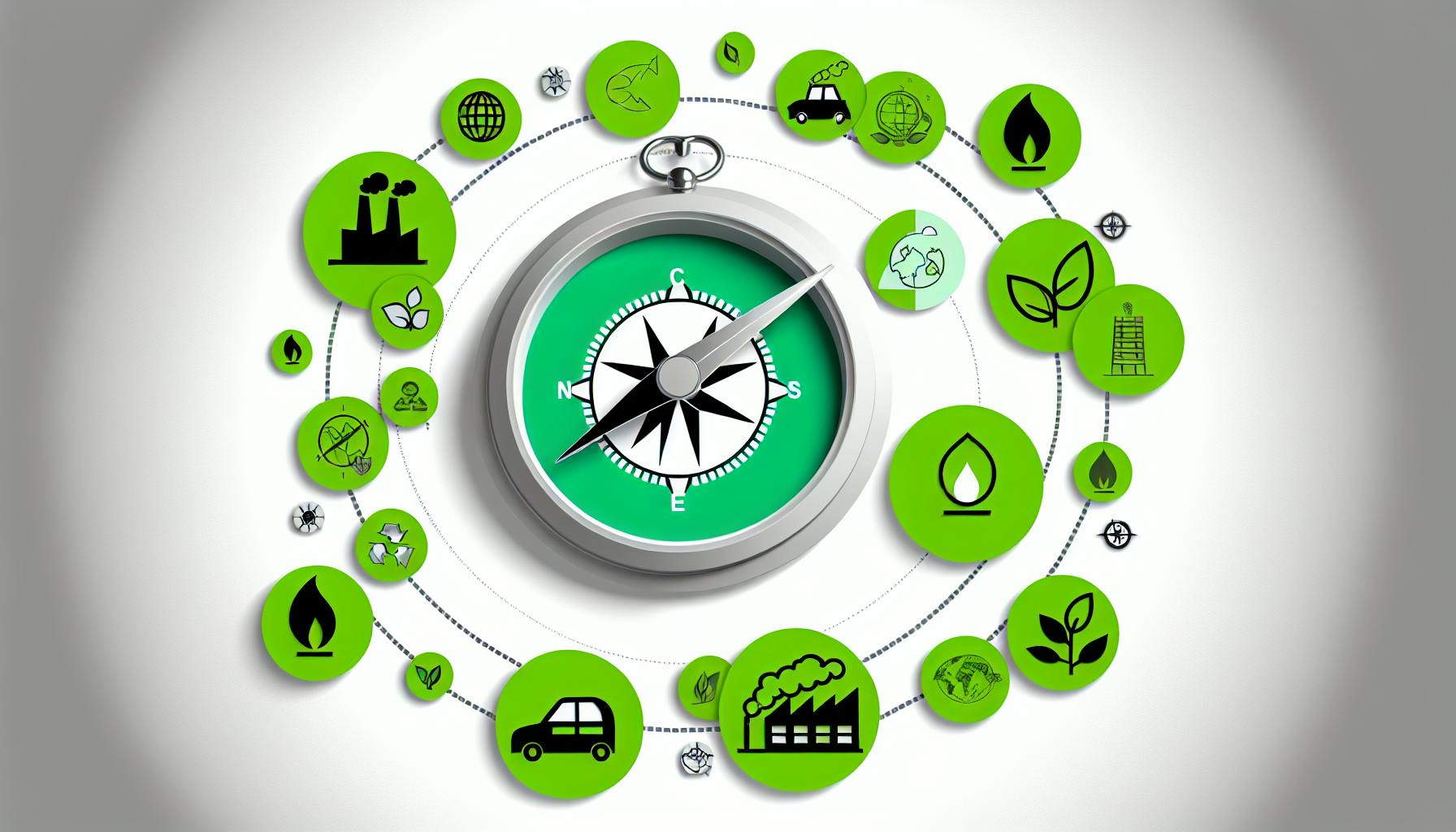Most businesses understand that petrol carbon emissions contribute to climate change, but may not realise the significant role they play in an SME's carbon footprint.
By analysing petrol use and emissions from fleet vehicles, SMEs can benchmark current levels, identify reduction opportunities, and communicate progress to stakeholders.
This article will provide an in-depth look at assessing petrol carbon emissions, gathering accurate data, implementing reduction strategies, and leveraging low-carbon efforts for branding and sustainability reporting advantages.
Assessing Petrol's Carbon Footprint in SME Operations
This section will provide an overview of how burning petrol in vehicles contributes to carbon emissions, and why accurately measuring this is crucial for an SME's environmental responsibility.
The Significance of Petrol Carbon Emissions for SMEs
When accounting for an SME's carbon footprint, it's important to consider "well-to-wheel" emissions from burning petrol in vehicles. This includes emissions from extracting crude oil from the ground, transporting and refining it into petrol, and ultimately combusting it in vehicle engines. These emissions fall under "scope 3" indirect emissions in the Greenhouse Gas Protocol.
While many SMEs focus first on scope 1 and 2 emissions from their own operations, scope 3 emissions often make up the majority of an organisation's carbon footprint. For companies relying on transportation for operations or distribution, accurately tracking emissions from burning petrol is key for comprehensive environmental reporting.
Global Perspective: How Much CO2 Do Cars Emit Worldwide?
Transportation accounts for around 24% of direct CO2 emissions from fuel combustion globally. With increasing stakeholder pressures and emerging regulations around sustainability reporting, comprehensive carbon accounting is becoming essential.
For example, the EU aims to cut transport emissions by 90% by 2050. So understanding the climate impact of transportation will only grow in importance for SMEs in the coming years. Adopting appropriate tools now allows businesses to get ahead of these trends.
Adopting a Petrol Carbon Emissions Calculator for Your Business
When choosing a carbon accounting platform, key aspects to consider are:
- Methodology: Aligning with GHG Protocol scopes and using accurate emissions factors.
- Customisation: Flexibility to tailor for your operations and vehicles.
- Automation: Seamless integrations to pull reliable data automatically.
Understanding the significance of petrol emissions, and adopting the right tools to measure them, allows SMEs to account for their full climate impact. This provides a foundation for science-based strategies to reduce emissions from transportation.
How much carbon does petrol emit?
Petrol is a major source of carbon emissions for many small and medium enterprises (SMEs). When accounting for your company's carbon footprint, it's important to understand how much CO2 is produced from burning petrol.
According to the U.S. Environmental Protection Agency (EPA), a typical passenger vehicle emits about 4.6 metric tons of CO2 per year. This assumes a fuel economy of 22.2 miles per gallon and an average annual mileage of 11,500 miles. Based on the carbon content of petrol, every gallon burned produces roughly 8,887 grams of CO2.
To estimate your company's petrol carbon emissions, you'll need to know:
- Total gallons of petrol consumed annually by your fleet vehicles
- Average fuel economy of each vehicle model
- Annual mileage for each vehicle
Plugging this data into a petrol carbon emissions calculator helps determine the total CO2 emissions attributable to petrol use. As an SME, petrol likely accounts for a significant portion of your overall carbon footprint. Understanding its impact is the first step to managing and reducing emissions over time.
Accurately tracking and reporting how much CO2 cars emit supports sustainability initiatives like fleet electrification. It also shows stakeholders your commitment to decarbonisation. Automated carbon accounting platforms like EcoHedge simplify the entire process from measurement to stakeholder engagement.
What is the carbon emission factor for petrol?
The carbon emission factor for petrol refers to the amount of carbon dioxide (CO2) emitted per unit of petrol consumed.
According to the U.S. Energy Information Administration (EIA), when a gallon of petrol is burned, approximately 8.89 × 10^-3 metric tons of CO2 are emitted. This value is known as the emission factor and is used to calculate overall CO2 emissions from petrol consumption.
The emission factor is derived using the heat content and carbon content of petrol. Petrol has a heat content of approximately 5.2 million British thermal units (BTUs) per barrel. It also contains about 2,421 pounds of carbon per barrel.
When petrol is burned, the carbon is oxidised and joins with oxygen to produce CO2. By accounting for the ratios of heat content, carbon content, and molecular weights, we can calculate the amount of CO2 released per unit of petrol consumed.
Knowing the emission factor for petrol allows companies to easily estimate overall CO2 emissions stemming from their vehicle fleets and operations. By multiplying total petrol usage data by 8.89 × 10^-3 metric tons CO2/gallon, an accurate carbon footprint measurement can be obtained.
Accurately tracking petrol carbon emissions is an important step for organisations working to reduce their environmental impacts and achieve net-zero emissions goals. EcoHedge's software can simplify this emissions accounting process.
How bad is petrol for the environment?
Petrol and diesel fuel combustion in vehicles produces several harmful air pollutants, including nitrogen oxides, particulate matter, volatile organic compounds, and greenhouse gases like carbon dioxide. These emissions contribute to environmental issues like climate change, acid rain, and health problems.
According to the EPA, transportation accounts for around 29% of total U.S. greenhouse gas emissions, with light-duty vehicles making up over half of that. Most concerning is that transportation greenhouse gas emissions have increased more in absolute terms than any other sector over the last 30 years.
When it comes to your small or medium-sized enterprise's (SME's) carbon footprint, emissions from any company vehicles you operate can represent a sizable portion. By measuring and reporting your petrol carbon emissions specifically, you can better understand this part of your footprint. This allows you to set effective reduction targets and communicate progress to stakeholders.
Some ways your SME could reduce petrol emissions include:
- Installing telematics to monitor vehicle idling and improve driving efficiency
- Considering electric or hybrid models for your next company car purchase
- Letting employees work from home when possible to reduce commuting
With EcoHedge's carbon accounting software, you can easily track emissions from mobile combustion sources like vehicles and integrate the data into your overall footprint calculations. This level of petrol carbon emissions insight empowers your business to make smarter decisions for reaching net zero.
sbb-itb-919600f
Which emits more CO2 diesel or petrol?
Diesel engines are generally considered more efficient than petrol engines, allowing diesel vehicles to travel further on the same amount of fuel. However, the story is more complex when comparing the carbon emissions of diesel versus petrol.
Although diesel contains more energy per gallon, it also has a higher carbon content. When burned, this releases more CO2 per gallon than petrol. Most modern studies have found that on a per-mile basis, today's diesel vehicles actually emit 10-20% more CO2 than their petrol counterparts.
There are a few reasons for this difference:
- Diesel's higher carbon-to-hydrogen ratio - With 12-15% more carbon per gallon, diesel emits more CO2 by design when burned as fuel. Petrol has less carbon per unit of energy.
- Emission control technologies - Modern petrol vehicles have very effective catalytic converters to curb CO2 output. Diesels do not use catalytic converters and have fewer options to limit tailpipe CO2.
- Testing procedures - Lab tests tend to overestimate diesel's efficiency benefits compared to real-world driving. In actual on-road use, diesels often fall short of advertised performance.
So while diesel vehicles are still more fuel efficient overall, meaning they can travel farther on the same tank, most emit higher greenhouse gases per mile driven. Of course, there are many other factors to consider as well in choosing diesel over petrol, but carbon emissions may favor petrol despite common perception. Sustainable biofuels and newer engine tech could also shift the balance going forward.
Petrol Consumption and Carbon Emissions in SME Fleets
Petrol consumption from vehicle fleets can represent a significant portion of an SME's overall carbon footprint. Accurately measuring and reporting these emissions is key for sustainability compliance and effective stakeholder engagement on climate action.
This section provides guidance on assessing petrol emissions specifically from SME readers' vehicle fleets. We outline methods for gathering necessary data, analysing factors like emissions rates for different vehicle models, addressing data challenges, and validating accuracy.
Gathering Data: Fleet Size, Vehicle Types, and Petrol Use
The first step is quantifying basic details of your fleet and related petrol usage:
- Fleet size: Document total number of vehicles across sedan cars, light trucks, heavy trucks, and any other vehicle types.
- Models and ages: Record model, make, year for each vehicle. Newer models tend to be more fuel-efficient.
- Annual mileage: Track total miles/kilometres travelled per vehicle annually. Higher mileage means greater fuel burned.
- Fuel efficiency: List miles or kilometres per gallon/litre for each vehicle. Found on window sticker or owner's manual.
- Fuel type: Note petrol versus diesel since factors differ. Hybrids use less fuel than traditional engines.
- Total petrol consumed: Add up total gas purchased for the fleet annually in gallons/litres. Receipts provide this data.
Documenting this information allows accurate analysis of emissions later. Fleet management software also increasingly automates data collection via telematics.
Analysing Emissions: CO2 Emissions by Car Model and Fuel Type
Once fleet data is gathered, emissions analysis examines CO2 emitted per unit of fuel burned. Petrol emits 8,887 grams CO2 per gallon burned, while diesel emits 10,180 g CO2 per gallon.
Emissions also vary by vehicle model and characteristics like fuel efficiency. Below is a chart of emissions rates by popular car models in the UK:
Vehicle Model
Avg CO2 g/km
Ford Focus
108 g/km
Vauxhall Astra
120 g/km
Volkswagen Golf
115 g/km
Check sources like Honest John for factors tailored to your vehicle types and country. Having accurate rates is key for credible carbon accounting.
Navigating Data Challenges: Estimations and Assumptions
In practice, SMEs often face incomplete fleet data. But perfect data should not hinder progress in sustainability journeys.
Where data gaps exist, make reasonable estimations using industry benchmarks. Document the approach to enable external verification later.
For example, if total fuel consumption data is unavailable, multiply total miles travelled by average miles per gallon for each vehicle. This approximates gallons burned.
Though not perfect, using thoughtful estimations where needed enables moving forward to assess and act on emissions.
Assuring Accuracy: Approaches to Validate Your Carbon Emissions Data
To confirm your analysis methodology yields accurate results, leverage free online calculators like EPAs GHG Equivalencies Calculator.
For more advanced assurance, explore third-party verification services that audit analysis processes against protocols like the GHG Protocol Corporate Standard.
While daunting initially, measuring fleets emissions precisely gets easier over time. The key is making a start with the data you have, then iteratively improving accuracy. The rewards for your business sustainability journey will be well worth the effort.
Effective Measures to Lower Petrol-Related Emissions
This section explores practical steps readers can take to minimise their petrol emissions through fleet optimization, electric vehicles, biofuels, and more.
Route Optimisation and Eco-Driving: Strategies for Efficiency
Optimising delivery routes and employing eco-driving techniques are effective ways to improve fuel efficiency and reduce emissions from petrol-powered vehicles.
Route optimisation software can analyse delivery patterns and customer locations to create the most efficient routes. This allows companies to service the same customers while driving fewer miles. Some key benefits include:
- Reduced mileage resulting in lower fuel costs and carbon emissions
- Increased number of stops per trip
- Improved customer service with faster deliveries
- Driver satisfaction from less time on the road
Eco-driving refers to driving habits that conserve fuel and minimise emissions. Key eco-driving tips include:
- Accelerating and braking smoothly
- Maintaining optimal speeds
- Anticipating traffic patterns ahead
- Monitoring tires for proper inflation
Incentive programs can motivate drivers to learn and apply eco-driving principles. Studies show that 5-10% MPG improvements are possible. Combined with route optimization, significant petrol emission reductions are achievable.
Transitioning to Low-Emissions Vehicles: Hybrids and EVs
Electrifying all or part of a fleet with hybrid or fully electric vehicles can drastically cut petrol consumption and emissions. Assessing when this transition makes economic sense involves:
- Comparing EV/hybrid acquisition costs to petrol vehicle alternatives
- Factor long-term TCO with lower maintenance and fueling costs
- Reviewing current driving routes and daily mileage needs
- Ensuring adequate EV charging infrastructure exists onsite or along routes
If daily mileage needs are lower, hybrids and EVs can be a smart, sustainable switch. The falling cost of lithium-ion batteries has made their lifecycle ownership costs competitive with petrol vehicles in many use cases.
The Role of Alternative Fuels in Reducing Petrol Emissions
Certain alternatives like biodiesel, renewable diesel, ethanol blends, propane, and natural gas can minimise fleet emissions. Their advantages and limitations compared to petrol include:
Biodiesel
- Produced from vegetable oils or animal fats
- Cleaner emissions but slightly lower MPG
- Higher cost may limit feasibility
Ethanol
- Typically blended ~10% with petrol (E10)
- Increased emissions of acetaldehyde may offset benefits
Propane & Natural Gas
- Useful for return-to-base fleet vehicles
- Require special fueling infrastructure
Renewable Diesel
- Chemically similar to petro diesel but made from organic matter
- Lower particulate emissions, higher fuel costs
The economic and environmental case for these alternatives depends heavily on fleet operations and routes.
Offsetting Unavoidable Petrol Emissions: Carbon Credits and Projects
High-quality, verified carbon offsets enable companies to mitigate the impact of unavoidable fleet emissions.
Offsets should meet key criteria:
- Additional - Project creates reduction not occurring otherwise
- Measurable & Verified - Emission savings quantified and validated
- Permanent - Reductions cannot be reversed
- Synchronous - Occur around same period as associated emissions
While offsets don't eliminate the root emissions, they fund equivalent emissions savings globally. Popular offset types include renewable energy, forest conservation, methane capture etc.
Choosing offsets aligned with corporate ESG priorities creates compelling stakeholder narratives around climate action. The key is selecting offsets delivering demonstrated, audited impacts.
Showcasing Your SME's Commitment to Lowering Petrol Emissions
Reducing petrol emissions from transportation can be an impactful way for small and medium-sized enterprises (SMEs) to lower their overall carbon footprint. As sustainability reporting becomes more prevalent, effectively communicating your petrol emissions and reduction efforts is key to demonstrating your organisation's commitment to environmental stewardship.
Emissions Reporting: Meeting Regulatory and Voluntary Standards
Emerging regulations around the world are requiring certain companies, including SMEs, to measure and disclose their greenhouse gas (GHG) emissions. For example, the SEC climate disclosure rule in the US requires public companies to report Scope 1 and Scope 2 emissions, which for many includes emissions from owned/leased vehicles and employee commuting. Companies aiming for net-zero also pledge to reduce value chain (Scope 3) emissions over time, which encompass transportation like business travel and logistics.
Using a purpose-built platform like EcoHedge allows SMEs to easily track emissions across Scopes and assess the impact of vehicles and commutes. This ensures your business has accurate emissions data to meet current and future compliance needs, as well as pursue eco-labels and voluntary reporting programs.
Measuring and Minimising: A Summary of SME Petrol Emission Strategies
In this concluding section, we revisit the central themes around understanding, measuring and reducing fleet emissions for SMEs seeking to shrink their carbon footprint.
Benchmarking Petrol Emissions: Car CO2 Emissions Per Km
To accurately quantify your company's petrol carbon emissions, you first need visibility into key metrics like:
- Total number of vehicles in your fleet
- Average fuel efficiency for each vehicle model
- Total mileage driven per vehicle annually
With this data, you can easily calculate emissions using online tools like the petrol carbon emissions calculator. As a rule of thumb, petrol-powered vehicles emit approximately 0.35 kg of CO2 per km travelled.
Monitoring additional factors like engine size, fuel type, and driving conditions provides even greater precision on your fleet's carbon impact. Tracking emissions over time allows you to set reduction goals and evaluate progress.
Recap of Reduction Techniques: Maximising Fleet Efficiency
We covered various methods for minimizing your SME's petrol emissions, including:
- Switching to hybrid or electric vehicles: Dramatically lowers tailpipe emissions through partial or full electrification.
- Eco-driving training programs: Optimizes driving habits for less aggressive acceleration/braking and improved fuel economy.
- Route optimisation: Reduces mileage and fuel waste through coordinated dispatching and trip planning.
- Vehicle maintenance: Following recommended service schedules improves MPG and prevents excess emissions.
Combined, these initiatives can shrink your carbon footprint by over 30% in many cases. Refer to earlier sections for details on implementation.
Leveraging Carbon Reduction for Business Advantages
A robust understanding of your petrol carbon emissions opens doors for strategic advantage:
- Enhanced branding & PR: Communicate your sustainability achievements through eco-conscious marketing campaigns.
- Regulatory compliance: Adhere to current and emerging market standards around carbon reporting and reductions.
- Investor/customer appeal: Cater to stakeholder demand for quantifiable and meaningful climate action.
Let your vehicle emissions inventory tell a compelling story of corporate responsibility and environmental stewardship.



